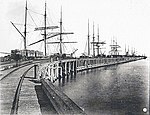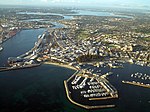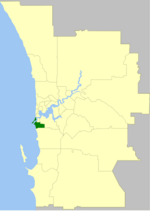Bathers Beach, Fremantle
Beaches of Western AustraliaFremantleUse Australian English from May 2013Whaling stations in Australia

Bathers Beach, also known as Whalers Beach, is a section of coastline that has a written history since the European settlement of what is now called Fremantle, Western Australia. In the 1890s it was bounded to the south by the Long and Short jetties. In the 1930s and 1940s it was called City Beach.The water offshore has also been called Bathers Bay. It is the shore below the Round House and is located just south of Arthur Head, at the entrance to Fremantle Harbour with the South Mole starting at its northern side.
Excerpt from the Wikipedia article Bathers Beach, Fremantle (License: CC BY-SA 3.0, Authors, Images).Bathers Beach, Fremantle
Mews Road,
Geographical coordinates (GPS) Address Nearby Places Show on map
Geographical coordinates (GPS)
| Latitude | Longitude |
|---|---|
| N -32.0585 ° | E 115.7418 ° |
Address
Mews Road
6160
Western Australia, Australia
Open on Google Maps










